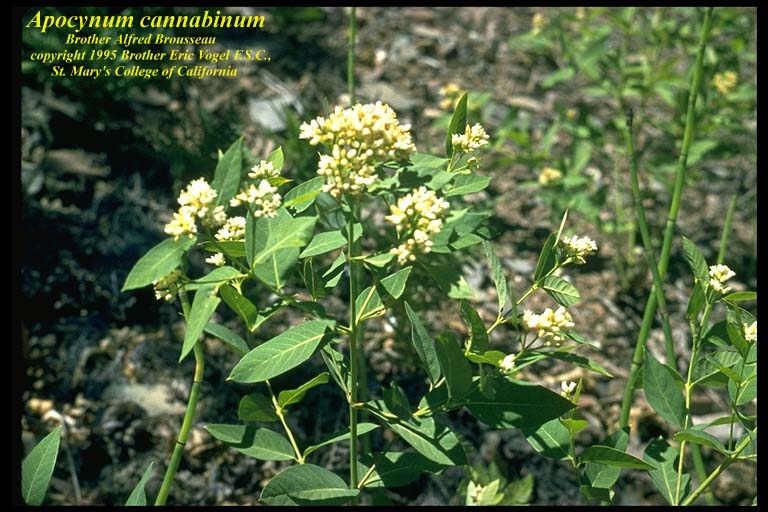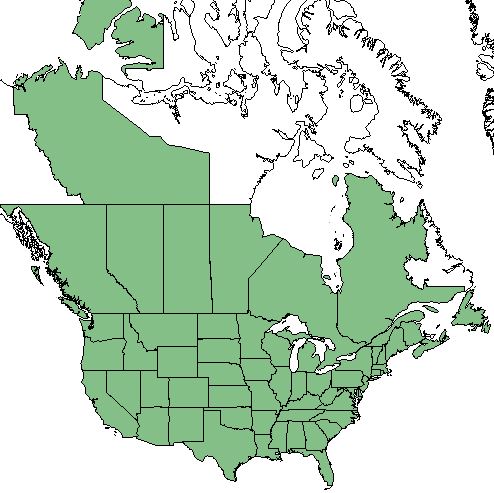Difference between revisions of "Apocynum cannabinum"
(→Seed dispersal) |
|||
| Line 38: | Line 38: | ||
===Seed dispersal=== | ===Seed dispersal=== | ||
| − | The seeds are adapted with white silky hairs for wind dispersal, and the light-weight seed is also able to float to conduct water dispersal. <ref name= "DiTommaso"/> | + | The seeds are adapted with white silky hairs for wind dispersal, and the light-weight seed is also able to float to conduct water dispersal.<ref name= "DiTommaso"/> |
===Seed bank and germination=== | ===Seed bank and germination=== | ||
Revision as of 13:06, 14 March 2019
Common names: hemp dogbane; Indianhemp
| Apocynum cannabinum | |
|---|---|

| |
| Photo by the Atlas of Florida Plants Database | |
| Scientific classification | |
| Kingdom: | Plantae |
| Division: | Magnoliophyta - Flowering plants |
| Class: | Magnoliopsida - Dicots |
| Order: | Gentianales |
| Family: | Apocynaceae |
| Genus: | Apocynum |
| Species: | A. cannabinum |
| Binomial name | |
| Apocynum cannabinum (L) | |

| |
| Natural range of Apocynum cannabinum from USDA NRCS Plants Database. | |
Contents
Taxonomic Notes
Synonyms: Apocynum cannabinum var. cannabinum, Apocynum cannabinum var. pubescens (Mitchell) Woodson, Apocynum cannabinum var. nemorale (G.S. Miller) Fernald, Apocynum cannabinum var. glaberrimumA.L.P.P. de Candolle, Apocynum cannabinum var. greeneanum(Béguinot & Belosersky) Woodson.
Varieties: none
Description
A. cannabinum, also known as Indianhemp, is a native member of the Apocynaceae family, with a perennial forb growth habit.[1] It grows to a height between 2 to 4 feet with erect branches and sharp-pointed leaves.[2] It also is a tough and fibrous plant which produces a milky latex sap like other Milkweeds. The A. cannabinum root system consists of horizontal roots and short rhizomes.[3]
Distribution
In Florida, reports of A. cannabinum range from Escambia County, eastward to Clay and Volusia Counties, and southward to Hernando and Brevard Counties.[4] Otherwise, it can be found throughout the United States in thickets and borders of old fields in pine forests.[2] The species can be seen as a generalist and can grow in numerous types of habitats, but is most common along shores and flood plains.[3]
Ecology
Habitat
A. cannabinum can be found in natural communities as well as human disturbed habitats across the United States.[2] It has been described as occurring in cedar glades, prairies, barrens, and various types of disturbed sites,[5] and in mountain longleaf pine communities.[6] The species can be found over a wide variety of soil types, including dry soil, sandy soil, rocky soil, alluvial gravel, silt, loam, clay, calcareous soil, mineral soils near hot springs, and sometimes peaty soil.[3] For disturbed sites, A. cannabinum can be found in damp swales adjacent to roads, in old fields, weedy roadsides, wastes, banks, and other types of roadsides.[7]
Phenology
Seed production occurs in the summer and matures in the fall, which can be found in the follicle of the species. Aside from this form of reproduction, A. cannabinum can also reproduce from vegetative reproduction in the rhizomes.[3]
Seed dispersal
The seeds are adapted with white silky hairs for wind dispersal, and the light-weight seed is also able to float to conduct water dispersal.[3]
Seed bank and germination
Seed dormancy in A. cannabinum can range from 50% to essentially no seed dormancy and germination occurring within a year of burial. For temperature, Apocynum cannabinum germinates at a range of 20-35° C. [3].
Pollination
A. cannabinum is predominantly pollinated by insects attracted to the fragrance and nectar of the flower [3]. Insects of the family Halicitidae, including Augochlora pura and Augochlorella aurata, have been recorded to be pollinators.[8]
Use by animals
The species receives its herbivore damage from generalist insects found within the community [3]. It is a host plant to the blue milkweed beetle (Chrysochus cobaltinus), which can cause severe defoliation.[9] Larvae of the beetle feed only on roots.[9]
Conservation and Management
Cultivation and restoration
Photo Gallery
References and notes
- ↑ USDA Plants Database URL: https://plants.usda.gov/core/profile?symbol=APCA
- ↑ 2.0 2.1 2.2 Sievers, A. F. (1930). American medicinal plants of commercial importance. Washington, USDA.
- ↑ 3.0 3.1 3.2 3.3 3.4 3.5 3.6 3.7 DiTommaso, A., et al. (2009). "The Biology of Canadian Weeds. 143. Apocynum cannabinum L." Canadian Journal of Plant Science 89: 977-992.
- ↑ Observation by Roger Hammer in Falling Waters State Park, Washington County, FL, January 9, 2018, posted to Florida Flora and Ecosystematics Facebook Group August 4, 2017
- ↑ Baskin, C. C. and J. M. Baskin 2003. The Vascular Flora of Cedar Glades of the Southeastern United States and Its Phytogeographical Relationships. Journal of the Torrey Botanical Society 130:101-118.
- ↑ Cipollini, M. L., J. Culberson, C. Strippelhoff, T. Baldvins and K. Miller 2012. Herbaceous plants and grasses in a mountain longleaf pine forest undergoing restoration: a survey and comparative study. Southeastern Naturalist 11:637-668.
- ↑ Florida State University Robert K. Godfrey Herbarium database. URL: http://herbarium.bio.fsu.edu. Last accessed: June 2018. Collectors: Loran C. Anderson, George P. Sawyer Jr., Harry E. Ahles, Norlan C. Henderson, Tom Daggy, S/ F/ Blake, George T. Jones, Robert K. Godfrey, R. L. Lazor, Michael B. Brooks, Sidney McDaniel, Delzie Demaree, Clyde F. Reed, R. L. Wilbur, R. Kral, and S. W. Leonard. States and counties: Florida: Wakulla, Jefferson, Franklin, Gadsden, Suwannee, Jackson, Flagler, Taylor, Dixie, and Washington. Georgia: Thomas, and Clarke. Maryland: Baltimore, and Harford. Utah: Grand. Alabama: Geneva. Louisiana: Caddo. Massachusetts: unknown. North Carolina: Wake, Mecklenburg, Franklin, Gates, Currituck, and Granville. Mississippi: Harrison, Lowndes, and Okibbeha. California: Fresno. Arkansas: Pulaski, St Francis, and Marion. Indiana: Vanderburgh, Huntington, and Monroe. Texas: Freestone, Callahan, and Roberts. Missouri: Atchison, Barry, Greene, and Buchanan. Tennessee: Sumner. Ohio: Ashland. Virginia: Arlington. Illinois: White. West Virginia: Lewis.
- ↑ Grundel, R., et al. (2011). "A survey of bees (Hymenoptera: Apoidea) of the Indiana Dunes and Northwest Indiana, USA." Journal of the Kansas Entomological Society 84(2): 105-138.
- ↑ 9.0 9.1 Borders, B. and E. Lee-Mader 2014. Milkweeds: A conservation practitioner's guide. The Xerces Society for Invertebrate Conservation, Portland 146 pg.